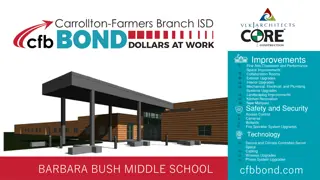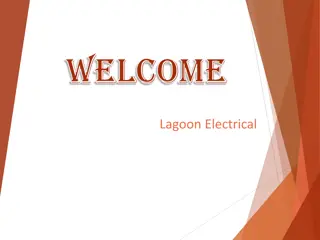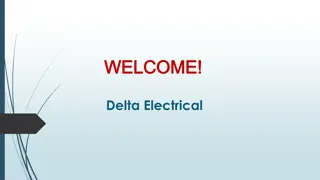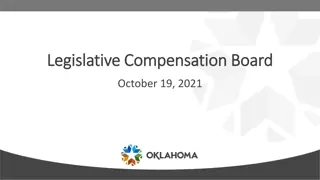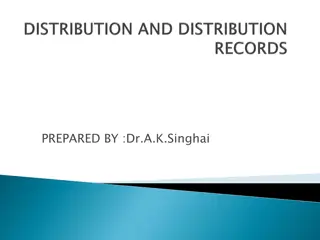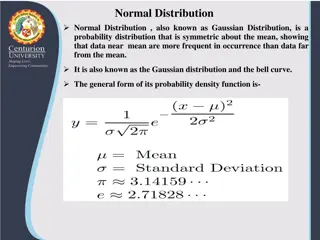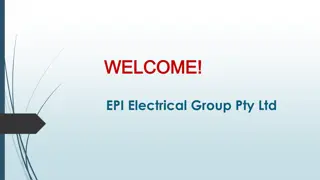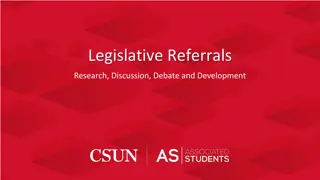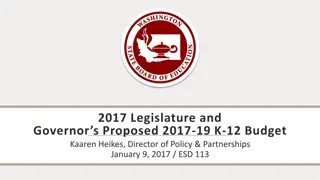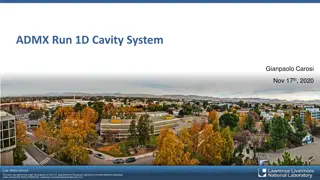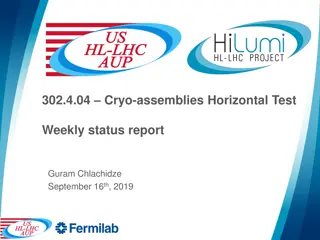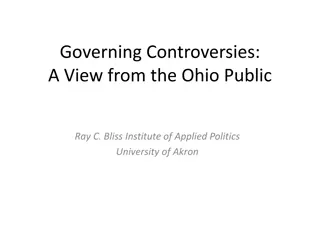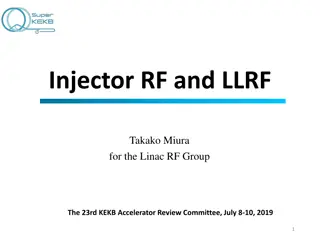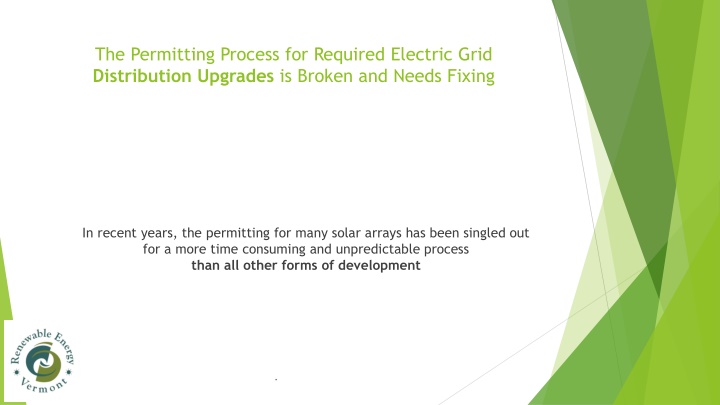
Solving Permitting Challenges in Electric Grid Distribution Upgrades
Overcoming the broken permitting process for electric grid distribution upgrades, especially concerning solar arrays, is crucial for streamlining development. Challenges in permitting solar arrays and stricter standards for distribution upgrades present obstacles that need addressing to facilitate renewable projects efficiently.
Download Presentation

Please find below an Image/Link to download the presentation.
The content on the website is provided AS IS for your information and personal use only. It may not be sold, licensed, or shared on other websites without obtaining consent from the author. If you encounter any issues during the download, it is possible that the publisher has removed the file from their server.
You are allowed to download the files provided on this website for personal or commercial use, subject to the condition that they are used lawfully. All files are the property of their respective owners.
The content on the website is provided AS IS for your information and personal use only. It may not be sold, licensed, or shared on other websites without obtaining consent from the author.
E N D
Presentation Transcript
The Permitting Process for Required Electric Grid Distribution Upgrades is Broken and Needs Fixing In recent years, the permitting for many solar arrays has been singled out for a more time consuming and unpredictable process than all other forms of development
New Developments Require Changes to the Electric Grid Including Line Extensions and Upgrades Upgrades to existing lines include switching to heavier gauge wire, adding/moving power poles, and upgrading transformers. Line extensions consisting of new wires and poles are required to connect to existing power lines. Heavier wire and additional poles in the existing right-of-way New poles and wires
Electric Grid Infrastructure Requiring Distribution Upgrades Are Usually Not in Pristine Locations Existing distribution infrastructure is: generally located along roadsides regularly undergoes vegetative maintenance (clearing, mowing, application of herbicides) often located on private property and subject to the mowing, landscaping and farming decisions of the landowner Since 2020, VT utilities have moved/installed over 6,500 poles Utilities routinely obtain the necessary permits and/or follow Best Management Practices for these distribution upgrades Maintenance in the wake of storms, including replacing poles, is routinely conducted without advanced permitting REV is unaware of any significant environmental issues caused by the utilities management of these distribution upgrades.
Solar Array Connecting to the Electric Grid Requiring a Distribution Upgrade New pole in the existing right-of-way Solar Array
Increasingly, Distribution Upgrades for Solar Projects are Facing Stricter Standards Than All Other Forms of Development For most distribution upgrades, utilities follow Best Management Practices and/or obtain all necessary permits For some solar projects, ANR is now requiring the builder, rather than the utility, to conduct environmental assessments and permitting for these upgrades before a CPG is granted This provides no environmental benefit but makes it much more challenging to build renewable projects Based on information from ANR, this first occurred on one project in 2006 and not again until 2017 but is now happening with increasing frequency though there have been no changes in Rules or statutes to mandate this change REV is unaware of this ever being required of any Act 250 project!
Why is This a Problem? ANR s new requirements introduces three major problems to the Section 248 CPG process 1. Lack of Legal Access to the Land that Must Be Assessed Project developers do not own, lease, or have a right to access the land under existing distribution infrastructure. If the landowner for this property refuses access to it, conducting an environmental assessment becomes impossible. 2. Sequencing Because ANR s new procedure requires the environmental assessment to be conducted prior to the completion of permitting, it increases the burden on utility staff time and the risk for developers since time-consuming distribution upgrade studies must be completed for projects that may never be successfully permitted 3. Legal Jeopardy This new procedure places conditions on the developer s permit for work done by the utility and thus creates a legal obligation for the developer for actions that they cannot control
Allowing Solar Projects to Use the Same Process As All Other Distribution Upgrades and Development Won t Harm Vermont s Natural Resources! Legislation that makes it explicit that the environmental review for distribution upgrades for Section 248 projects should be the same as for other types of distribution upgrades is needed to: 1. Ensure renewable energy development will face the same scrutiny as other forms of development rather than experiencing added hurdles 2. Allow utilities to do the well-managed permitting work they already do on the vast majority of distribution upgrades on all solar projects 3. Return to historical practices that have protected Vermont s natural resources While ANR cites a 2006 case as the precedent for these requirements, it has not been, and is not now, standard procedure for Section 248 projects This clarification leaves the financial responsibility of developers unchanged Developers remain responsible for the full cost of the distribution upgrades performed by the utilities including all planning, study, materials, and labor costs



